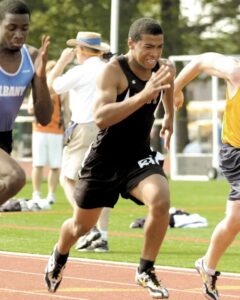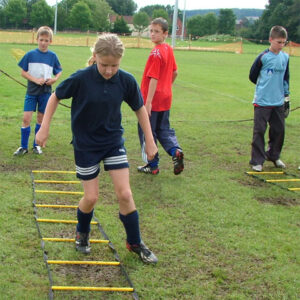
“Make My Kid Run Faster”
Since we work with quite a few young athletes, it’s the question I get a few times every week:
“Will you be doing speed training with my son/daughter? He/she needs to get faster.”
In my head, I am always thinking, “No, all our programs are geared toward making athletes slower. It’s really what we do best.”
Kidding aside, what comes out of my mouth is markedly different, as I have to explain how our training approach is going to be dictated by where that young athlete is developmentally – and each kid really is unique.
On one hand, you’ll have young athletes who have very poor mobility and stability – which equates to terrible body control. Sadly, this has become the majority of 13-16 year-old athletes in the U.S. today thanks to a tendency toward early sports specialization and excessive computer time.
Given the crazy ground reaction forces (roughly 4-6 times body weight on one leg in each stride; or 600-900lbs for a 150lb kid) an athlete experiences during sprinting, you could make the argument that taking these untrained, physically incapable kids and throwing them into aggressive sprinting and change-of-direction drills could actually be considered very dangerous. They simply don’t have the eccentric strength to decelerate this pounding, let alone create optimal subsequent concentric actions. These athletes need time to develop a good foundation of strength and mobility – upon which good landing mechanics can be taught later in shorter, simpler drills. Eventually, once they’ve developed some body control, they can make better use of true sprint training and agility work.
Or can they?
While these young athletes probably aren’t ready for being thrown into the fire in their training (closed-loop, or predictable, drills), what do they do outside of the gym? They participate year-round in sports (open-loop, unpredictable/chaotic).
This is like recognizing that the engine on your 1979 Pinto is a ticking time-bomb and bringing it in to a mechanic for an hour a week for an oil change – only to take it out and drive it in the Daytona 500…every other day. You’re swimming upstream.
So, the question becomes: do today’s “always in-season” high school athletes EVER get to the point that they really need much dedicated agility and sprint work? Based on the preceding few paragraphs, for some athletes, I’d say no; they don’t need much. Some foam rolling, a good dynamic warm-up, followed by some quick and to-the-point movement drills, and then solid resistance training should get the job done as long as they’re out there competing in their sports.
On the other hand, while it is not a common circumstance nowadays, you do actually have advanced athletes (those with a decent foundation of strength) who may have periods of the year when they aren’t actively involved in organized sports. These athletes absolutely do need to train with specific sprinting and change of direction work during these “off” periods of the year. We generally program this work for days completely separate from lifting, although it can also be worked in between the warm-ups and resistance training components. It’s of vital importance to recognize that these athletes can only make the most of these inclusions because they’ve put in the leg work (no pun intended) to make these high-stress reactive drills really beneficial and safe.
You know what’s funny, though?
The athletes who get to this more advanced stage have already gotten faster – because along the way, they’ve learned to put more force into the ground, and have improved their ankle and hip mobility. They’ve become faster without ever spending much, if any, time at all on sprinting and agility drills. And, once they have that foundation of strength, these supplemental movement drills actually work a lot better.
It’s like a big circle. They build a foundation of strength, which helps them develop reactive ability. They train that reactive ability further, and it brings them further to the “absolute speed” end of the continuum. So, they lift heavier weights – which brings them back toward the center of that continuum, and, in turn, allows them to train reactive ability even harder because they’re running faster, jumping higher, and turning on a dime better than ever.
If you don’t understand what I mean, check this old video I did out:
The entry level kids I mentioned earlier aren’t even on a continuum. They are on the “exerciser/non-exerciser” seesaw. Make them regular exercisers and build up some strength, and they wind up starting on the absolute speed end of the continuum because all they’ve ever known is running around. They won’t run faster until you get ‘em strong and shift them over to the absolute strength end of the continuum – and that simply won’t happen if you’re just spending 90 minutes of each session with them running agility ladders and doing skipping drills.
Why then, if the amount of movement training needed is grossly overestimated, do we have so many coaches and facilities in this industry who spend hours per week on movement training? Very simply, money makes the world go round. In other words, you can “safely” train a lot more kids in large groups and make it less coaching-intensive on yourself if you just set up cones, hurdles, and agility ladders and tell them to go to town. Actually getting a kid strong takes more individualized cues and variety in exercise programming. And, because strength exercises are more high-risk/high-reward, they take more one-on-one coaching – which is tough to do when you have twenty 13-year-olds and only one coach. This is one reason why I have always said that I will never let our business model dictate our training model at Cressey Sports Performance.
So, to wrap it all up: some kids need movement training, and some kids aren’t quite ready for it. And, 99% of the time – while it might fly in the face of logic – if the parent comments on how slow a kid is, just having that young athlete go out and run more is the least effective, most dangerous way to address the issue.
For more information on the current state of youth athlete development and how to best set young athletes up for success, I highly recommend you check out Mike Boyle’s new resource, Complete Youth Training. It’s on sale for $50 off through this Sunday at midnight. You can learn more HERE.
Sign-up Today for our FREE Newsletter and Receive a Detailed Video Tutorial on How to Deadlift!








